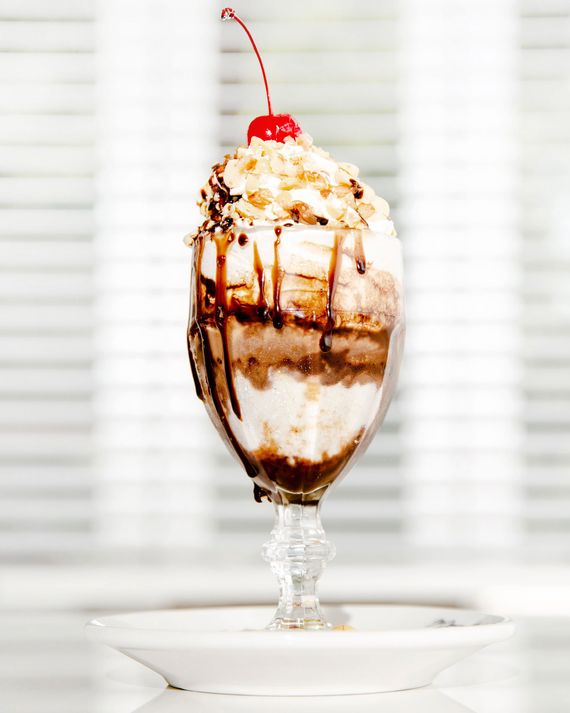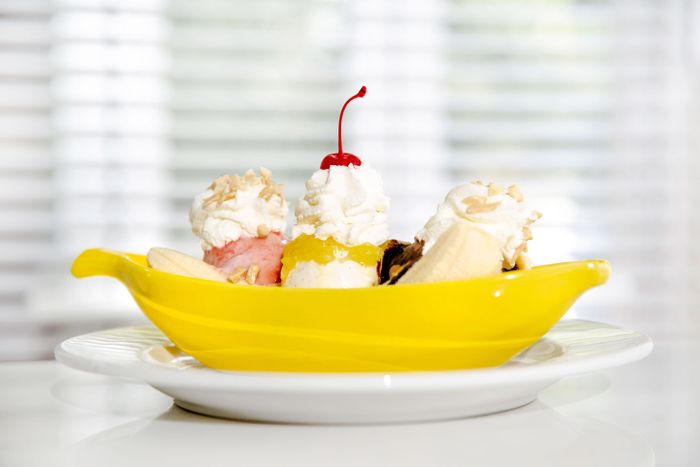
On a Saturday night, at the height of summer, 50 or so people flood the gleaming-white interior of the Morgenstern’s Finest Ice Cream parlor on the corner of Houston and La Guardia Place. They crane necks and taste samples to decide which of the shop’s 88 flavors they will order (and, perhaps, post to Instagram), but a few feet away, Nick Morgenstern himself stands behind a comparatively quiet eight-seat luncheonette-style counter, focused on a sundae. There, a handful of people perch on swivel stools, plunge spoons into craggy dips dripping with various sauces, and brush whipped cream from top lips.
Morgenstern — rangy and clad in white Dickies, a white apron, a white T-shirt, white Birkenstocks, and a white paper diner hat covering his shaved head — reaches over and corrects the lean of several scoops of ice cream that an employee has stacked into a glass sundae dish. The correction is only a few degrees, a minor tweak at most, but it makes the stack perfect. “I try not to be a looney tune about this kind of stuff — I’m not trying to be Di Fara,” he says, referencing the Midwood pizza joint run by the monastic Dom DeMarco. Instead, Morgenstern says, “the sense of obligation here is relative to how much time and money I’ve put in.”
Everything about his two ice-cream shops is specific, down to the color of the storefronts (Delft blue), the range of vanilla and chocolate (there are seven varieties of each), and the term he uses for a scoop (a “dip”). He’s even asked customers to leave if their attitudes don’t align with the ice-cream-shop ideal. “This place looks the way it does because that’s how it should look,” Morgenstern emphasizes. “The way things taste,” he adds, “is how they should taste.”
Morgenstern’s new sundae counter, which is open only on Friday and Saturday nights and which occupies a tiny sliver of real estate on the side of the flagship Houston Street shop, might be the most complete embodiment of his all-consuming pursuit. It’s hidden in plain sight, but discovering it can feel a bit like stumbling upon the Room of Requirement, a place meant for a specific kind of seeker, one pining for spiritual communion with precision, nostalgia, and an enthusiasm for the meaning of the American sundae that has been, heretofore, unknown.
“It’s an interesting idea,” Morgenstern says, “to try to figure out historically what this thing was and serve it the way that it was then, here and now.” A serious student of his trade, Morgenstern has pored over old pharmacy menus and druggist catalogues to uncover the sundae’s origins. He can tell you about the first banana split ever made, back in Latrobe, Pennsylvania. He’s scoured estate sales for old sundae dishes, unearthing a series of footed tin cups in England, digging up several banana-split boats at two separate auctions, and a few rare green-glass dishes he’d never seen before or since.
If you ask, Morgenstern will explain, exactingly, that the scoops in a banana split should be separate so that their individual toppings do not commingle unnecessarily. The ice cream in a strawberry-shortcake sundae, meanwhile, should be vertical, not horizontal, so whipped cream can cascade down the sides. The Hot Tin Roof — that classic combination of vanilla ice cream, chocolate, and peanuts — should have sauce that is viscous but not thick. The nuts should be crushed Picosos’ peanuts from Texas, and the Maraschino cherry on top should be bright red and perfectly generic, because anything else would be wrong.
These, plus a frilly Grasshopper, a brownie à la mode, and a shortcake-laden butter-pecan option, are the classics that make up half of Morgenstern’s sundae menu. They are simple but dogmatic. The other half is more maximal yet no less refined. Instead of being timeless, they are representations of the country’s collective palate right now, which straddles the conventions of sundae-dom while occasionally subverting it. The New God Flow, something of a Morgenstern’s staple since debuting at the original shop on the Lower East Side, is a mess of melting raw-milk ice cream, brûléed honey, and Japanese white bread, served on a plate. Salted caramel pretzel makes for a heaping mass of salty-sweet juxtaposition.
Perhaps the most elaborate of the new-look choices is the Rosenthal, a collaboration between Morgenstern and Somebody Feed Phil’s Phil Rosenthal. The sundae requires 12 separate elements — ice creams and whipped creams and sauces and “crunchies” and sea salt — that are inspired by Rosenthal’s love of Reese’s, as well as its classic advertising slogan, “You got your peanut butter on my chocolate! You got your chocolate on my peanut butter!” It’s a straightforward idea, but nailing the execution was, as one might guess, trying. “We had arguments about it,” Morgenstern says.
Rosenthal says the conversations did get heated, but he ultimately deferred to Morgenstern because he knew he was working with “a serious artist … a serious person. If you met him, and he told you he worked for NASA, you would believe him,” Rosenthal says. “Yes, he dresses like the Good Humor man, but he’s very disciplined.”
Where does such discipline and precision come from? You could point to Morgenstern’s childhood, when he wasn’t allowed sweets at home in Northern California but would eat ice cream after “every single meal” while visiting his grandparents in Ohio. (Here, he was introduced to Dairy Queen and the Peanut Buster Parfait, i.e., the Hot Tin Roof, which remains his ideal sundae.) You could mention that Morgenstern put himself through culinary school in San Francisco while working as an auto mechanic and that his first cooking job was as a commissary baker at an Army base in Heidelberg, Germany, where, at a rate of $250 per week, he baked cakes and pastries for galas and the base’s shops. Then there’s Morgenstern’s pastry work at Michael Mina’s Aqua restaurant, his stint cooking at a strip club and in the vaunted pastry kitchens at Manhattan’s Daniel and Gramercy Tavern. All of these experiences are legible in one way or another in his shops, his 88 flavors, and his sundaes.
Sitting at the sundae bar calls to mind the attentive intensity of a high-grade sushi counter. The deliberate movements are as studied as they are earnest. Order something, and out come the pastry bags, batches of brownies and blondies, plastic quart containers of chocolate shards, precisely calibrated textures of crushed nuts, and maybe a blowtorch. Almost always, Morgenstern is behind the counter, studying, examining, and tweaking every detail.
Without exception, Morgenstern’s sundaes feel both old and new, like recalling some possibly imagined instant of childhood bliss. There’s the mound of whipped cream resting perilously upon a dip of vanilla, nuts scattered across; there’s the long spoon’s dive in, sending ice cream and sauce sloshing over the side; there’s the sensation that everything is exactly how it is supposed to taste. “That’s the moment we hunt for without even knowing it,” Rosenthal says. At Morgenstern’s, the sundaes do exactly what they should do.






